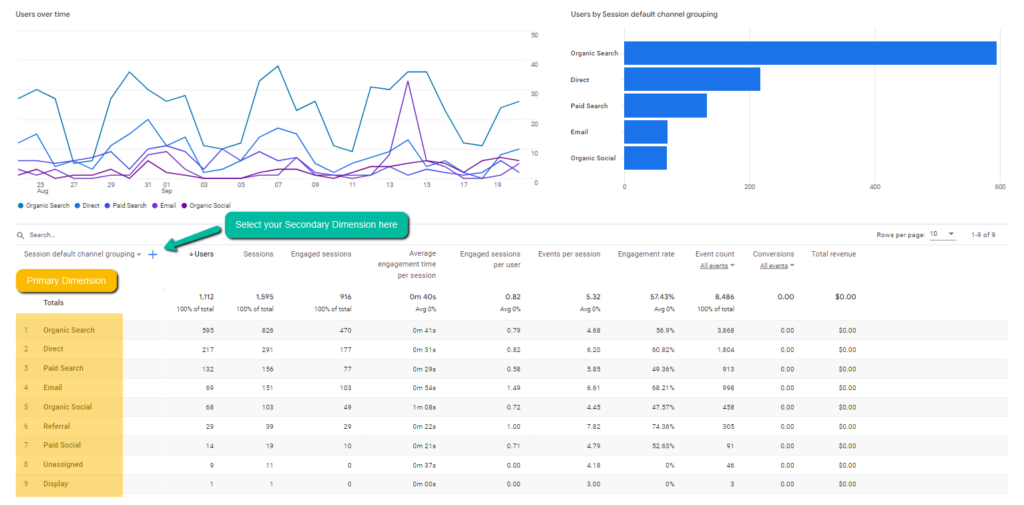The Importance of Secondary Dimension in Google Analytics for Your search engine optimization
The Importance of Secondary Dimension in Google Analytics for Your search engine optimization
Blog Article
Enhance Your Information Evaluation Using Secondary Dimension in Google Analytics
Checking out the abilities of secondary dimensions in Google Analytics opens a world of possibilities for refining information analysis. By layering extra measurements onto primary data sets, a more elaborate narrative emerges, dropping light on customer communications and efficiency indicators.
Comprehending Second Dimensions
In the realm of information analysis, an essential element to grasp is the idea of additional dimensions and their value in removing much deeper understandings from Google Analytics reports. Secondary measurements in Google Analytics describe additional parameters that can be included in the primary dimension, permitting for a much more in-depth analysis of data. By integrating second dimensions, experts can segment and filter data to discover patterns, fads, and correlations that may not be obvious when checking out the information overall. These secondary dimensions can offer context and an extra thorough understanding of individual behavior, traffic sources, and various other key metrics tracked by Google Analytics.

Benefits of Utilizing Secondary Measurements
When assessing information in Google Analytics, the utilization of secondary measurements supplies important understandings into user habits and performance metrics. By including an additional measurement to your main information, you can delve much deeper right into the attributes of your website site visitors and their interactions. One of the crucial benefits of making use of secondary measurements is the capability to section and compare information extra successfully. This division allows you to recognize just how different variables, such as demographics or web traffic sources, effect customer actions and conversions (Secondary Dimension in Google Analytics).
Additionally, additional dimensions help in determining patterns and connections that might not be right away noticeable when looking at the data in isolation. This much deeper degree of analysis can discover important details that can guide advertising and marketing approaches, internet site optimization, and general business decisions. Additionally, secondary measurements enhance the context of your main data, providing an extra detailed view of user engagement and efficiency metrics. On the whole, the use of additional dimensions in Google Analytics can significantly boost the depth and quality of your data evaluation, resulting in even more informed decision-making and enhanced end results.
Just How to Add Additional Dimensions
By incorporating second dimensions in Google Analytics, customers can acquire much deeper insights right into their information evaluation process, permitting more thorough analysis of customer habits and efficiency metrics. Including additional dimensions is a simple procedure that can dramatically improve the deepness of analysis. To include an additional measurement in Google Analytics, begin by browsing to the report you want to analyze. When in the record, find the "Second dimension" tab over the information table. Click on it to disclose a dropdown menu with numerous options such as Actions, Innovation, and Customized Dimensions. Select the dimension you want to add, such as 'Source/Medium' or 'Device Classification'. This second dimension will then be related to your existing data, providing additional context and enabling an extra comprehensive evaluation of user communications. By utilizing additional measurements efficiently, users can reveal valuable insights that might have otherwise been overlooked, see this site causing informed decision-making and boosted performance methods.
Analyzing Information With Second Dimensions
Utilizing additional dimensions in information evaluation provides a much more thorough understanding of customer actions and performance metrics. By including a second measurement to your key data established in Google Analytics, you can dive deeper right into the features of your site site visitors and their communications. For instance, integrating the primary dimension of 'source/medium' with the second dimension of 'touchdown web page' can reveal which specific pages are attracting traffic from various sources, aiding you enhance these pages for far better interaction.

Essentially, evaluating data with second measurements encourages you to gain useful insights right into customer habits, recognize trends, and make informed decisions to enhance the efficiency of your electronic buildings.
Best Practices for Additional Measurements
In data analysis, incorporating secondary measurements successfully can dramatically improve the deepness of understandings stemmed from metrics and user behavior patterns. When utilizing second measurements in anonymous Google Analytics or any other analytical device, it is critical to comply with best practices to guarantee the accuracy and importance of the information analysis.
One secret finest technique is to meticulously pick second dimensions that enhance the main measurement being evaluated. Picking second dimensions that give extra context or further division can provide an extra extensive understanding of the data. It is additionally important to avoid overcomplicating the evaluation by including too lots of secondary measurements, which might result in confusion or dilution of understandings.
Moreover, it is a good idea to try out different combinations of additional and main measurements to reveal new relationships and trends. Routinely refining the choice and evaluating of second measurements based on the certain objectives of the analysis can bring about more workable insights. By following these finest techniques, data analysts can take advantage of additional dimensions properly to boost the general data analysis process and decision-making capacities.

Final Thought
To conclude, incorporating additional dimensions in Google Analytics is vital for a thorough data evaluation approach. By leveraging secondary measurements together with key ones, marketing experts and experts can discover valuable insights and connections that can notify decision-making and maximize digital advertising approaches. Comprehending just how to efficiently make use of secondary measurements and following ideal techniques will permit professionals to extract meaningful information and improve their total performance metrics.
Additional measurements in Google Analytics refer to added specifications that can be included to the primary dimension, allowing for a much more detailed analysis of data. By integrating second dimensions, analysts can sector and filter data to uncover patterns, fads, and correlations that may not be apparent when looking at the information as a whole. Integrating the main measurement of 'source/medium' with the secondary dimension of 'landing web page' can find out here reveal which certain web pages are drawing in traffic from various sources, helping you maximize these web pages for far better interaction.
One key finest practice is to meticulously select second measurements that match the key measurement being evaluated. By following these finest practices, data experts can take advantage of secondary measurements efficiently to enhance the general information evaluation process and decision-making capabilities.
Report this page